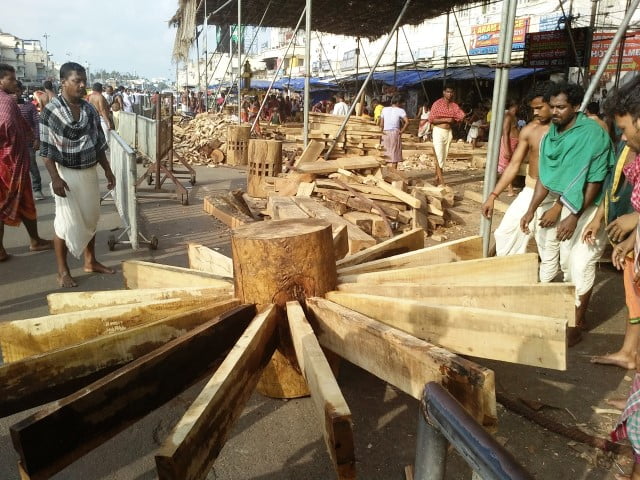He Smiles To See The Grand Chariots Roll On Bada Danda!

Bhubaneswar: The Lords will begin the homeward journey on the chariots now facing southward at the Gundicha Temple on Sunday. Witnessing the annual sojourn of the deities from Jagannath Temple to the aunt’s place was once in a lifetime experience for those who flocked to the Holy Town during the nine-day festival.
However, for Rabi Bhoi, who has been a part of chariot-making since 16 years, it is more than seeking blessings. “The Lord gives us food in real terms, if we say so. Six months of hard work comes into play during the festival and we are overwhelmed at how everything falls into place perfectly. The Lord is here, among us all, even in the smallest of work we do,” expressed an elated Rabi.
He, along with 77 other Bhois are a part of the assembling team of the chariot. In an exclusive chat with Odisha Bytes prior to the festival, Rabi not only told us about the process of making the chariot but also took us to the spot where wood was being chopped and ‘sarathi’ being painted. We walked across the Grand Road where the chariots were being decorated. He explained the tit-bits of the process very patiently. His eyes sparkled with passion and kept us hooked to the entire tale of chariot making.
Rath Yatra, as the name suggests, is born out of the magnanimity of the chariots. Here are some facts about the ‘Rath’, as shared by Rabi Bhoi.
1. The construction of the chariots begin on Akshaya Tritiya, roughly two months before Rath Yatra, which is an auspicious day in the Hindu calendar.

2. Seven groups of workers are involved in making the chariots in their entirety. They are, Viswakarma or Maharana, who do the actual construction; Karati or carpenters who help cut the wood; Bhois who carry the wood and assemble it; Lohara, or blacksmith who work with iron, the Roopkars or wood carving artistes who create sculptures around the chariot; the Chitrakars or painters, who make different motifs and paint the chariots and Darji or the tailors who work on the cloth pieces used in the chariots.

3. More than 200 people are involved in the process. Of these, 77 are Bhois who play a major role even after the construction is completed, in moving and steering the chariots.

4. These group of men and their families have been doing this for generations now.

5. The constructed chariots have specific height and number of wheels that never change.
6. Jagannath’s chariot Nandighosh is 45.5 ft high with 16 wheels and the roof is covered with red and yellow fabric.

7. Balabhadra’s chariot Taladhwaja, is 45 ft high, has 14 wheels and the roof is covered with red and green cloth.

8. Subhadra’s chariot, Devidalana, is 44.5 ft high, has 12 wheels and the roof is covered with red and black fabric.

9. The estimated budget for this year’s Rath Yatra festival was Rs 6 crore.

10. Around 865 trees are cut every year to build these. The chariots are carved out of Asana, Dhaura, Simli and Phasi species of trees.

11. The wood is brought from Nayagarh and Khurda, for which certain processions are followed.

12. Each piece of carved wood has a different name.
- The wheels of the chariots are prepared first. The part of the wheel so prepared is known as ‘Kumbha’.

14. No iron nails are used and yet they stand strong. Reason? Some incredible assembling and huge nails made of wood are used. The process is locally known as ‘salabendha’.

15. After the festival gets over, Bhois dismantle the chariots. The wood is then used as fuel to cook food for the Lord. The wheels of the Rath are also sold or displayed for worship.

Comments are closed.